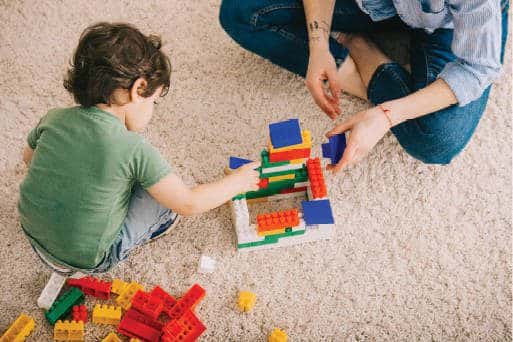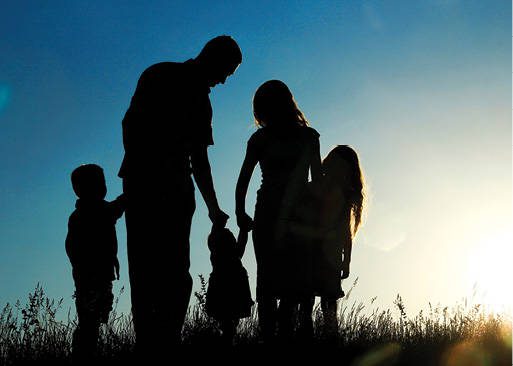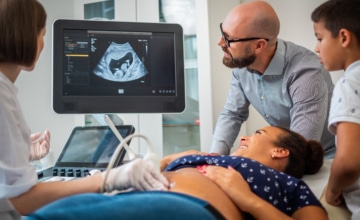Marian E. Williams, University of Southern California
Kathleen Mulrooney, ZERO TO THREE, Washington, DC
Ashley Rediker, Children’s Hospital Los Angeles, Los Angeles, California
Debbie Reno-Smith, Riverside County, California
Noelle Hause, ZERO TO THREE, Washington, DC

Abstract
ZERO TO THREE and Los Angeles County Department of Mental Health (LACDMH) collaborated and contracted to provide official DC:0–5TM clinical training and foundational infant and early childhood mental health training to clinicians from Los Angeles (LA) County, California, over the course of 3 years. This article describes this unique, multiyear clinical workforce development effort highlighting the specific training approaches and supports used, considerations for sustainability, DC:0–5 Expert Faculty reflections, and participants’ feedback. The authors provide recommendations for possible replication of this intensive workforce development effort.
In 2017, Los Angeles County Department of Mental Health (LACDMH) and ZERO TO THREE agreed to embark on a multiyear professional development project to bring DC:0–5 clinical training and supports, as well as other infant and early childhood mental health (IECMH) offerings, to a vast number of professionals serving organizations funded by LACDMH. DC:0–5TM: Diagnostic Classification of Mental Health and Developmental Disorders of Infancy and Early Childhood (ZERO TO THREE, 2016) represents an updated diagnostic classification system for diagnosing disorders in infants and young children that is comprehensive in scope, empirically based, developmentally appropriate, contextually driven, and culturally informed. LACDMH had previously provided training on the prior version of this classification system (DC:0–3R; ZERO TO THREE, 2005) and was highly motivated to make DC:0–5 training available at a much more intensive level to as many clinicians throughout Los Angeles (LA) County as possible. In this article, the authors will present the history and context of the IECMH workforce in LA County, the comprehensive array of professional development and learning support delivered through the ZERO TO THREE–LACDMH contracts, reflections from two key DC:0–5 Expert Faculty, as well as conclusions and recommendations.
Initiatives to Develop the Birth to 5 Workforce in LA County
DC:0–5 training in LA County has occurred within the context of system-wide efforts over the past 30 years to improve access to mental health services for children from birth to 5 years old and their families, championed by the LACDMH—the largest mental health system in the country (see Learn More box). For this article, we interviewed some of the key leaders in this effort to explore the history and levers of change, including Sam Chan, PhD, Veronica Chavez, PhD, Carolyn Kaneko, LCSW, Marie K. Poulsen, PhD, Ana Verdin-Hernandez, LMFT, and Lesli Yoshihara, LCSW. Progress has been shaped by people (passionate leaders and networks), programs (grants and program development), pressure (lawsuits), and funding priorities (legislation). Dr. Chan described, “There was a conceptual framework that guided us. Promotion, prevention, early intervention, and a focus on underserved, under-represented communities of color.”
In the mid-1990s, a lawsuit against the California Department of Health Services led to a dramatic expansion of funding and provision of specialty mental health services for children and adolescents with Medicaid under the Early and Periodic Screening, Diagnosis and Treatment benefit (Snowden et al., 2007). Although not focused solely on young children, this funding expansion opened the door to develop creative approaches to intervening early to prevent later mental health disorders and address early childhood adversity. Then in 1998, California voters passed Proposition 10 (The California Children and Families Act), which increased tobacco taxes to support programs for young children and led to the establishment of First 5 California (https://www.ccfc.ca.gov).
In the late 1990s, four counties were awarded capacity-building grants from the California First 5 Commission through the state Department of Mental Health to develop and pilot IECMH initiatives. In LA County, this grant led to the development of the ICARE Network (Infancy, Childhood and Relationship Enrichment Network) which continues to this day and has included collaboration from numerous mental health agencies, representatives from additional LA County departments (child care, child welfare, education, maternal and child health, and public health), the Part C early intervention program, First 5 LA, ZERO TO THREE Western Office, and more. The initiative grew from providing technical assistance to a small number of agencies, to developing training guidelines for core competencies leading to state IECMH endorsement (California Center for Infant-Family and Early Childhood Mental Health, 2003, 2016). Dr. Chan noted, “The field was accelerating so fast with so much new information. We needed a set of core competencies.”
Several initiatives in the 2000s built on this foundational work. From 2003 to 2021, LACDMH developed Project ABC, a collaborative funded by the Substance Abuse and Mental Health Services Administration that included private nonprofit mental health agencies, university researchers, and child welfare and was designed to build an early childhood system of care (http://www.projectabc-la.org). In 2004, the Mental Health Services Act (MHSA) was passed by California voters (https://www.dhcs.ca.gov/services/MH/Pages/MH_Prop63). It instituted a tax on personal income over $1 million to fund prevention, early intervention, and intensive mental health services; this Act is generating more than $2.3 billion annually. As Dr. Chan said about MHSA, “It changed everything. We were boiling over with excitement. We were now in a place to do promotion and prevention with infant mental health.” Most recently, the Katie A. lawsuit led to a mandate in 2006 (implemented in 2011) requiring mental health screening and treatment for children in out-of-home placement in the child welfare system (http://www.bazelon.org/katie-a-v-bonta). Given that more than 30% of foster youth in LA County are younger than 5 years, and 20% are younger than 3 years, IEMCH is a critical area of need within the child welfare system.

Progress has been shaped by people (passionate leaders and networks), programs (grants and program development), pressure (lawsuits), and funding priorities (legislation). Photo: shutterstock/Rawpixel.com
As a result of funding from the MHSA and First 5 LA, and changes stemming from the Katie A. lawsuit, LACDMH was able to invest in building the birth-to-5 mental health workforce through a massive training effort. As Dr. Poulsen said, “Because of the work started by the ICARE Network, LA County was ready to jump on the opportunity created by MHSA.” This training effort included funding for the core curriculum that had been designed by the ICARE Network to meet endorsement competencies. In 2015, Children’s Hospital Los Angeles (CHLA) was awarded the first of several contracts leading to the delivery of 132 birth-to-5 mental health trainings, reaching more than 3,000 mental health providers over a 6-year period. Training sessions included Intake Assessment for Young Children, Brain Development and Implications for Attachment, Typical and Atypical Development, Trauma Response in Infants, Best Practices in Infant and Early Childhood Mental Health, Infant Mental Health Services for Medically Fragile Infants, and Sensory Integration and Implications for Mental Health Services With Young Children. In addition, CHLA conducted intensive 4-month training for 80 supervisors in reflective practice facilitation, and a year-long reflective practice mentor training for 8 supervisors. Finally, investments from MHSA funding and First 5 LA supported intensive training in child–parent psychotherapy (Lieberman & Van Horn, 2008) and parent–child interaction therapy (Funderburk & Eyberg, 2011) by the developers of those models, reaching hundreds of clinicians in LA County.

Given that more than 30% of foster youth in LA County are younger than 5 years, and 20% are younger than 3 years, infant and early childhood mental health is a critical area of need within the child welfare system. Photo: shutterstock/Lightfield Studios
When DC:0–5 was published, LACDMH committed to a sustained investment to allow the growing birth-to-5 workforce to complete state-of-the-art training to incorporate the use of the diagnostic manual within their work. As Veronica Chavez, PhD, noted, “People in LACDMH want to make sure families with young children are getting the best services, so there has been a big push for trainings to meet that need.”
DC:0–5 and IECMH Training Efforts in LA County
Building on the foundation, commitment, and investments already made in LA County to support IECMH professional development, representatives from LACDMH reached out to ZERO TO THREE in 2017 to plan for delivery of DC:0–5 training for LA County clinicians associated with LACDMH-funded agencies and organizations. A particular focus was reaching mental health professionals who provided screening and assessment of infants and young children in out-of-home placement within the child welfare system, who were tasked with identifying mental health needs and linking these families with specialty mental health services. In addition to the provision of DC:0–5 trainings (both intensive DC:0–5 clinical trainings and briefer DC:0–5 overview trainings), plans also included provision of additional IECMH topical trainings which would support those IECMH training opportunities already established in the county that had been cross-walked to the California IECMH Endorsement competency requirements. Contracts for the delivery of this collaborative work between ZERO TO THREE and LACDMH spanned from 2017 through the end of 2020 and included the provision of the following:
• 20 DC:0–5 clinical trainings (19 2-day in person trainings; 1 2-day, virtual training)
• 12 community of learner meetings for clinicians who completed DC:0–5 clinical trainings (follow-up support through optional 90-minute peer and faculty support calls)
• 5 DC:0–5 overview trainings for allied professionals
Over the 3-year period, a total of 1,011 clinicians were trained using the official DC:0–5 clinical training curriculum. Ana Verdin-Hernandez, LCSW, LACDMH training coordinator, noted, “The trainings got filled within hours of the training announcements going out.” This curriculum was standardized and manualized (Heller & Mulrooney, 2016) for use by specially selected ZERO TO THREE DC:0–5 Expert Faculty members who were licensed mental health clinicians. The DC:0–5 Expert Faculty have an average of 10 years of clinical experience in the field of IECMH as well as at least 5 years training experience on a national and/or international level. This curriculum was delivered primarily as an intensive 2-day, in-person offering by DC:0–5 Expert Faculty, although one training was delivered virtually after pandemic restrictions became necessary. Dr. Marian Williams and Debbie Reno-Smith were the primary faculty providing the training for LA County due to their proximity to the county. The DC:0–5 clinical training content modules are outlined in Box 1.
Box 1. DC:0–5 Training Modules:
• History and Foundations of Diagnosis of Mental Health Disorders in Infancy and Early Childhood
• Approaches to Diagnostic Formulation
• Axis III Physical Health Conditions and
Considerations
• Axis IV Psychosocial Stressors
• Axis V Developmental Competence
• Cultural Formulation for Use in Infancy and Toddlerhood
• Axis I Clinical Disorders
• Axis II Relational Context
Clinical Trainings
DC:0–5 clinical trainings provided an opportunity for participating clinicians to receive intensive training through a combination of modalities including didactic, small, and large group discussion; use of videotaped content; experiential activities; and case-based discussions and applications. Particularly meaningful and well-received were the discussions and activities related to cultural formulation and to the importance of reflection and cultural awareness in reducing implicit bias in the diagnostic process. As Ana Verdin-Hernandez commented, “The County has a high priority in providing training on cultural competence … The Cultural Formulation for Infants and Toddlers is an important focus for meeting the county’s priorities.” Participants were also able to apply their knowledge and learning through a case-based application activity in which clinicians were provided an extensive case report and asked to draft a DC:0–5 diagnostic summary based on the information provided. Discussions ensued to examine approaches to differential diagnosis and considerations for comorbidity (more than one clinical disorder) as well as to “unpack” their impressions on the contextual axes including Axis II Relational Context, Axis III Physical Health Conditions and Considerations, Axis IV Psychosocial Stressors, and Axis V Developmental Competence, as well as cultural context and influence. They were able to share their diagnostic impressions with others in the training and ultimately compare this with the diagnostic summary and case conceptualization of the developers of the case to align the reliability of their diagnostic impressions.
Follow-Up Support
In addition to this DC:0–5 training application activity, clinical application and practice utilization was also supported by the availability of up to 12 follow-up support meetings organized as 90-minute virtual community of learner teleconference calls. Clinicians were expected to come to these calls with specific DC:0–5 content or process questions and to have a diagnostic issue or case to share with the learning community. These calls were facilitated by DC:0–5 Expert Faculty or the IECMH leaders in ZERO TO THREE’S Professional Development and Workforce Innovation Department. The first half hour of the call focused on responding to specific questions about content of DC:0–5 or issues in implementing DC:0–5. The remaining hour involved case-based peer group discussion around diagnostic issues including differential diagnosis and use of the multiaxial framework. Often issues of complicated family structures and dynamics were the focus of understanding how best to consider the child’s symptoms and the child’s relational and cultural context. In many cases, the facilitator guided the group in considering impressions across all five axes culminating in a potential working diagnostic summary.
IECMH Topical Trainings
As mentioned previously, LACDMH also contracted for provision of several key IECMH topical trainings that would support clinician’s foundational knowledge around IECMH issues and better support and/or prepare them for their use of DC:0–5 in clinical practice. IECMH topical training sessions included: Foundations and Theoretical Perspectives of Infant and Early Childhood Mental Health, Neuro-relational Development, The Psychology of Pregnancy and Early Parenthood, Trauma-Informed Practice, Reflective Supervision in Practice, Observation and Assessment, Clinical Formulation and Relationship-Based Interventions, and Systems and Public Health Approaches for IECMH. The IECMH topics were offered up to 4 times per year for clinicians., A separate virtual training event on Systems and Public Health Approaches for IECMH was designed specifically for LA County policymakers and key administrators. This training included California and LA County–specific early childhood systems, resources, and challenges to present to these key stakeholders.

Participants were also able to apply their knowledge and learning through a case-based application activity in which clinicians were provided an extensive case report and asked to draft a DC:0–5 diagnostic summary based on the information provided. Photo: shutterstock/Maples Images
DC:0–5TM Training of Trainer (ToT)
In 2018, ZERO TO THREE moved to establish DC:0–5TM Training of Trainer (ToT) certification and curriculum to enable sustainability for DC:0–5 training at state and local community levels. This sustainability would be realized through the creation of cohorts of certified DC:0–5 trainers who could provide more frequent and less costly training options for local clinicians and allied professionals. LACDMH contracted to make this ToT available to 15 select, qualified licensed clinicians who were employees of LACDMH and committed to provide the DC:0–5 training to mental health professionals in the community. The 15 select clinicians attended the 3-day virtual ToT (including participant live teaching demonstrations). Upon completion of training, passing a knowledge assessment, drafting an annual training plan, and signing an agreement with LACDMH, these participants were certified as DC:0–5 trainers for LA County. Carolyn Kaneko, LCSW, spoke about LACDMH’s decision to support the ToT training: “It seems like every 7 years we have a dip in funding. So, in anticipation of that, I insisted that we needed to invest in Training of Trainers … We needed trainers that could sustain the work even when funding goes away or priorities shift.”
Between November 2020 and August 2021, the certified DC:0–5 trainers in LA County have provided five DC:0–5 clinical trainings for 154 clinicians (at the time of this writing, four additional trainings were planned for the fall of 2021). LACDMH created a unique approach toward coordinating the certified trainer’s efforts. The trainers in LA County are supported by the LACDMH in terms of coordination of training dates, provision of technical support and learning platform, live technical moderation during the training, and provision of continuing education and continuing education units. Certified DC:0–5 trainers from LA County have access to both ZERO TO THREE’s monthly community of learner (office hours) calls for certified trainers from around the country as well as DC:0–5 trainer cohort meetings offered through LACDMH.

Often issues of complicated family structures and dynamics were the focus of understanding how best to consider the child’s symptoms and the child’s relational and cultural context. Photo: shutterstock/KonstantinChristian
ZERO TO THREE has established rigorous training eligibility for certified DC:0–5 trainers, and the clinicians from LA County who participated in the ToT had to meet these criteria as well as agree to specialized terms through a signed agreement with LA County. For example, ZERO TO THREE requires provisional and fully certified trainers to conduct a minimum of one DC:0–5 clinical training per year whereas LA County DC:0-5 trainers are required to conduct a minimum of two DC:0–5 clinical trainings per calendar year while the certification fee was being paid by LACDMH (which will be until 2024). Also, the LA DC:0–5 certified trainers, whose ToT training and subsequent re-certifications fees were paid by LACDMH, had to agree to train only within LA County (not across the state of California) and to provide the trainings to clinicians who (1) work in LACDMH Directly Operated clinics and contract agencies and (2) are providing direct services to children birth to 5 years old. Certified DC:0–5 trainers in LA County also agree to provide the trainings and follow-up supports to LACDMH agencies at no cost. All trainers who were sponsored for the LA County ToT were employees of LACDMH. The terms of their agreement with LACDMH stated that if they left the employ of LACDMH before the end of 2024, they would have to repay the portion of the costs allotted for their training and certification fees.
These terms allowed for county-specific sustainability and are unlike other locations where ZERO TO THREE certified trainers operate, where they can provide training anywhere in their state and in many states are able to charge training fees for provision of DC:0–5. In LA County, when a ZERO TO THREE certified trainer leaves county employment, they are able to remain a certified trainer for California (if they continue to reside there) or their certification can be transportable to another state where they are employed if they continue to maintain certification with ZERO TO THREE.
DC:0–5 Expert Faculty Reflections on DC:0–5 Training in LA County
The following are reflections offered by Marian E. Williams, PhD, IECMH-RPM, and Debbie Reno-Smith, LMFT, IECMH-RPM, on their experience of delivering DC:0–5 clinical training in LACDMH sites over the course of the 3-year project.
Marian E. Williams Faculty Reflections
I have worked in the LA County public mental health system for more than 30 years, and for the past 18 years have led the IECMH program at CHLA that has a contract with LACDMH. So for me, training in the DC:0–5 in LA County feels like home. That local knowledge has enabled me to approach training from both a macro and a micro view. Macro in that I have been a part of the systems-level changes occurring in California and LA County and I see how the DC:0–5 training fits within that larger context. I remember collecting signatures to get the MHSA legislation on the ballot, so to see it fund training to build the birth-to-5 workforce in my community is especially gratifying. Micro in that I have supported clinicians and trainees who are working with young children and their families within this setting, as well as worked with families myself, and so I think about how the training applies to that work. Ultimately, who are the families we are serving, and what do they need us to know?
REFLECTIONS ON DIVERSITY
LA County is an ethnically diverse community, with less than 25% of the population being non-Hispanic White. There are more than 200 languages spoken in LA County, and 42% of the population are native Spanish speakers. Fortunately, the community of mental health professionals working at LACDMH contract agencies reflects the diversity of the larger population. And many clinicians have chosen to work for a community mental health agency because they want to reach underserved populations and ensure access to care for the most vulnerable families. I was struck during the trainings by the cultural diversity of our audiences. I was also struck by the passion I heard from participants for creating a more just society, and for considering the nuances of culture when considering mental health diagnosis. I began to devote more time in the training to discussing the cultural formulation and considering how culture influences all the axes in DC:0–5. I learned from listening to the various perspectives that were shared in the small groups and the larger discussions, and I saw the clinicians engage deeply in questioning their own assumptions and hearing others’ perspectives.
INTERFACE WITH DOCUMENTATION REQUIREMENTS
Community mental health professionals work in the context of numerous demands for specific documentation requirements, some at the direction of their county contracts and others due to their agency’s guidelines and the strictures of their electronic medical record. It was sometimes difficult for participants in the training to focus on the task of learning to use DC:0–5 when it did not fit within this documentation framework. For example, for most of the time that DC:0–5 training was rolling out, the intake assessment form used in LA County still referenced the DC:0–3R. Leadership in the county was working to revise the intake form, but this was a lengthy process from drafting changes to getting them approved to having them implemented at the agency level and integrated into electronic medical records systems. In addition, because state and county documentation and billing requirements focused on use of the DSM-5 (American Psychiatric Association, 2013) and the ICD-10 (World Health Organization, 2004), clinicians often got distracted by very specific questions about the diagnostic crosswalks.
COVID-19 PANDEMIC
We had to make the transition to virtual training very quickly after the stay-at-home order came in mid-March 2020. Our agency, CHLA, was in the midst of offering a series of birth-5 mental health trainings. We had a training scheduled for March 27, 2020, with 50 participants already enrolled. With 1-week notice, we decided to offer the training virtually. By the time I conducted my first DC:0–5 training virtually in August 2020, I was getting in the groove of virtual training. Participants were so grateful that training opportunities were continuing despite the pandemic. The interactive nature of the DC:0–5 training materials helped people to stay engaged and provided opportunities for people to connect with others outside their agency during a very challenging time. I’m sure that many of the breakout room discussions included sharing of tips for conducting tele-mental health with young children, even if that was not the topic assigned. And I know that many questions came up in the trainings about whether we could appropriately assess and diagnose a young child using only virtual sessions.
Debbie Reno-Smith Faculty Reflections
Over the course of the 3-year period, there was such a broad range of practitioners, coming from a variety of disciplines, with different backgrounds, education, and experience within the early childhood arena. There were no two groups of participants that were exactly alike. It was a desired opportunity and they viewed it as something that was going to help them in their daily work. Oftentimes they were looking for more, such as specific interventions and assessment tools, not realizing the difference between a diagnostic formulation process and the former.
PARTICIPANT ROLES AND DISCIPLINE
Participants were primarily clinicians, including those responsible for conducting assessments for children recently placed in foster care, supervisors, or administrators. As the training extended over time, there seemed to be more focus on system development, integration of the DC 0–5 formulation process into existing systems, and expanded participation from compliance and lead supervisors. There was a clear commitment by the LACDMH to develop both frontline professionals, and to identify key leaders who would work toward sustainability.

There are more than 200 languages spoken in LA County, and 42% of the population are native Spanish speakers. Photo: shutterstock/eddie-hernandez.com
INTRICACIES OF THE DC:0–5
Training on the DC:0–5 manual required an immense amount of preparation, adaptability, a high level of facilitation, humility, and the ability to navigate extremely challenging questions from the participants, which often did not have a clear-cut response. There were so many skilled and highly experienced providers in the room from such a broad range of backgrounds that it took a lot of energy to “hold” the emotions and inquiries over the 2 days.
Reflecting on my DC:0–5 training experiences in LA County, I walked away with a strong sense that the learning process for the DC:0–5 paralleled the actual work with the caregiver and the young child on the front line. I became attuned to each group through a set of “developmental lenses,” whereby over the course of the 2 days there was an evident trajectory that always started with participant uncertainty, doubt, and an unnamed layer of overwhelm and often unrecognized embedded values and beliefs that would become visible as the first day progressed. The presentation of the material over the course of the training unfolded and led the participants through an understanding of the core concepts of a developmental, culturally attuned, and relationship-based approach to diagnosis. It was fun to experience the moments of self-reflection and insight that came from participants and to see them challenge each other and themselves with inquiry. Not every participant was able to grasp the imperative element of self-reflection that is needed to do this work. Oftentimes there were one or two participants who came in with embedded and rigid ideologies that stirred up the room and created lively and sometimes difficult discussions.
PROFESSIONAL DEVELOPMENT GOALS AND PROGRESSION
From the very beginning of my work in LA County I was met by organizers who were on a “mission” to meet the massive goal of preparing professionals in a multitude of settings to take a common or shared approach to assessing, diagnosing, and treating children from birth through 5 years old. Initially there were only a handful of supervisors or agency/county leadership in the room and eventually there were more supervisors who were invested in being able to use the DC:0–5 as a supervisory tool to assist their teams in applying the diagnostic formulation process. It seemed as if it became evident that reliability, sustainability, and truly using learned content depended significantly upon the practices of leadership and system alignment.

The interactive nature of the DC:0–5 training materials helped people to stay engaged and provided opportunities for people to connect with others outside their agency during a very challenging time. Photo: shutterstock/Girts Ragelis
Over the course of the 3 years there was a clear developmental progression in the understanding that the participants would bring into the training. They often spoke about their use of the former diagnostic classification system, DC:0–3R, and the difference between that and DC:0–5. Their application of the diagnostic formulation in guiding the therapeutic interventions they were learning through a series of “core competency trainings” was also a focus. There seemed to be a clearer understanding of the role the DC:0–5 played in their programs, and they were able to approach the material with a deeper level of skill and application.
No matter how experienced a professional is in the diagnostic process, there is always more to learn and something new to walk away with when using the DC:0–5 in any type of clinical setting.
FACTORS FOR TRAINING SUCCESS
It was imperative to have familiarity with the community, an understanding of the real-life challenges that the participants faced on a daily basis. The trainer needed to be able to speak their language and apply the material in a way that aligned with their day-to-day experiences on the front line and in a large system of care. Something that seemed to lend to the success in LA. County’s professional development process was assigning a consistent point person throughout the entire 3 years. Eventually there was an expanded cadre of county “champions” who were available throughout every training. It felt like a partnership with the county representative and the trainer.
Every training was in a different location, based in the heart of the communities that were receiving services in LA County. Getting to know the community and who was in the room seemed to shape the trust in the room….and yes, it took a level of openness and trust to move through the 2 days of material in a productive manner. I called it “Setting the Stage.”
There were often challenges that hindered the participants from immediately using the manual in their work, such as agencies or systems that didn’t support the diagnostic process; paperwork and billing requirements that were recommended for the application of the DC:0–5, such as being able to include a multiaxial diagnostic summary in electronic health records; problems with crosswalking DC:0–5 disorders to ICD-10 disorder codes; or allowing 3–5 diagnostic assessment sessions before rendering a full diagnostic summary.
EXPERT TRAINER SUPPORT AND APPROACH
As a trainer it was important to have access to the DC:0–5 Expert Faculty community of practice group, as well as with someone in a lead role with ZERO TO THREE who was available to process the group dynamic, trainer learning points, and follow up with questions from the participants. There was always something different coming up, and as a trainer it was important to not try to have “all the answers.” Due to the depth of the DC:0–5 material, there was a continuous learning process on the part of the Expert Faculty and ZERO TO THREE.
As a trainer it was imperative to use examples and to model the principles that are the foundation of IECMH work such as relationship-based and reflective perspectives. Using a reflective approach while delivering the material and facilitating a professional learning process go hand in hand. If I wanted the participants to be open and vulnerable to exploring their own values, beliefs, and assumptions, then I too needed to model this throughout, particularly when challenges and disagreements were voiced. Adapting, attending, and moving the group through the material were all important aspects of the facilitation of the DC:0–5 using a relationship-based approach. This being said, it’s important that the trainer have some working exposure and application of the manual in an actual client care setting to be able to navigate and respond to the level of questions.
DC:0–5 Clinical Training Participant Feedback
The overwhelming feedback from clinicians who completed training evaluation surveys following their participation in the DC:0–5 clinical trainings was very positive. One respondent commented, “This training expanded my diagnostic competence.” Another noted, “The training provided exposure to an age group (0-5) [that I] was not familiar with.” Most respondents rated the training as “Very Good” or “Excellent” for having met its learning objectives, being organized, being well-presented, and having useful handouts and materials. Many commented on how “useable” the manual was and that the integration of the manual throughout the training made the content clearer and “user-friendly.” Many commented on how important and meaningful the discussions and activities related to cultural context in diagnosis were, while others wished this topic could have had even more time and emphasis. The question of time also had some mixed responses with some feeling that, while intense, the timing for the training was appropriate, others experienced the training as too lengthy, and others yet expressed a wish that it might be expanded into a 3-day training. There were many comments about the utility of the case examples, small group activities and discussions, and videos as contributing to the overall positive multimodal learning experience. Participants deeply valued the experience of applying knowledge to a case and exploring issues around differential diagnosis and cultural formulation. One supervisor commented, “As a supervisor this was very useful for working with my staff and providing guidance.”
Another component that was highly rated was the DC:0–5 approach to diagnosis and the in-depth training on the multiaxial framework. Clinicians validated the notion that this contextual framework provides a more dimensional and holistic understanding of the child and family’s experience and is crucial in driving case conceptualization and treatment planning. There were some expressed concerns as was alluded to in the previous DC:0–5 Expert Faculty reflections, about how DC:0–5 could be aligned with existing LACDMH assessments, and other documentation protocols. As the training progressed over the years, more sessions included LACDMH staff who could provide some brief guidance and clarification around alignment with required assessment and diagnosis and began also to provide separate trainings on this issue to complement the DC:0–5 curriculum content.
Overall, participants had high regard for the presenters’ knowledge, shared experiences, and facilitation skills as well as the energy and pace of the training. Some who had previously been trained on DC:0–3R were appreciative of the information that addressed what had changed and been revised from that version to the current DC:0–5. Others noted that the training represented all new information for them, and they embraced this knowledge with interest and excitement.
Conclusions
DC:0–5 has been a much-anticipated and widely used diagnostic classification system for clinicians working with infants, young children, and their families. LACDMH has made significant commitments to increasing professional development for the early childhood clinical workforce for more than 20 years, and LA County’s approach to DC:0–5 and IECMH clinical training represents one of the most intensive and comprehensive approaches to IECMH professional development in the US. This article described how LA County had successfully aligned DC:0–5 training and IECMH training with other established professional development efforts in the county and competencies for endorsement in the state of California. While continued alignments for reimbursements such as adopting crosswalks as well as for documentation through electronic records need to be more streamlined, efforts such as updating the ICARE assessment to reflect the DC0–5 multiaxial approach and impressions demonstrate progress in this effort to align. Clinicians in LA County have been highly motivated to participate in available trainings as is evidenced by the numbers trained during the years of the ZERO TO THREE contract period and continuing rates of attendance for trainings coordinated through LACDMH facilitated by certified DC:0–5 trainers.
Stakeholders from other locales may be concerned as they learn about LA County’s very detailed and extensive process that unfolded over years and involved statewide mandates, local efforts, leadership commitment and political support, along with provider investment. It may almost seem daunting and possibly overwhelming if a reader is trying to achieve something similar in their own state or community. Where would they even begin?
Small steps, perseverance, forward thinking, and engagement of champions from a variety of key stakeholders are key in achieving an integrated system of care and a broad cadre of competent and equipped professionals. It is important to scaffold on existing workforce development efforts and investments, building on what exists and expanding rather than starting from scratch.
Each community needs to begin where they are, take stock, evaluate what they already have in place, tap into their strengths, and identify key areas of focus. They very likely already have committed “experts” who would be eager to join a task force, committee, or community collaborative to work toward developing a strong infant and early childhood system of care. It is important to keep in mind that implementation is a process and will take place, and evolve, over time. Important strategies to consider when implementing a professional development effort around the use of DC:0–5 include maximizing funding, by not only training front line providers but also clinicians in supervisory and leadership roles, as well as planning early for sustainability.
Other key recommendations include the following:
• Provision of regular case-based diagnostic community of learner opportunities for DC:0–5–trained clinicians using the DC:0–5 multiaxial framework and/or provision of reflective supervision/consultation focusing on the diagnostic process. These supports not only assist clinicians in considering differential diagnosis issues but are also an important place to focus on cultural context and to explore clinician and organizational (institutional) cultural assumptions and beliefs as they relate to the children and families served. These sessions may be provided as a time-limited series or ongoing supports and would be beneficial in maintaining clinical interest, minimizing implicit diagnostic bias and misdiagnosis, and increasing diagnostic reliability.
• Ensuring professional development opportunities that represent cultural diversity and inclusion and allow for equitable access.
• Mental health systems contemplating similar initiatives should consider starting with technical assistance focused on aligning the assessment, documentation, and billing requirements with DC:0–5 diagnoses to support clinicians in fully integrating the diagnostic manual into their work.
• Pairing training in DC:0–5 with a training on intake assessment approaches with young children and families would provide an ideal foundational set of trainings for clinicians new to the birth-to-5 age group—an approach that LACDMH has now incorporated.
• Consideration of providing DC:0–5 training for multilingual clinical audiences using bilingual certified DC:0–5 trainers and, where possible, providing appropriate published translations of the DC:0–5 manual.
• It is important to align DC:0–5 clinical training efforts with local and state IECMH policy efforts, especially those related to reimbursement regulations, job contracts, and professional development requirements. Policies that recommend or require that clinicians who treat children under 6 years old use DC:0–5 as a developmentally appropriate diagnostic classification system will have powerful implications for clinician training and supports around DC:0–5.
• Sustainability includes a comprehensive integration of this diagnostic practice into multiple levels, including direct services, professional development, clinical role responsibilities, managerial oversight and supervision, and policy.
Acknowledgments
The authors wish to thank and recognize the following LACDMH colleagues for their leadership and cooperation in being interviewed for this article: Sam Chan, PhD, Veronica Chavez, PhD, Carolyn Kaneko, LCSW, Ana Verdin-Hernandez, LMFT, and Lesli Yoshihara, LCSW. In addition, we appreciate the input from Marie K. Poulsen, PhD, a leader in the implementation of IECMH in LA County through her work at the University of Southern California and CHLA.
Learn More
For a comprehensive explanation of the history and current state
of public mental health funding and service delivery in California,
see Arnquist, S., & Harbage, P. (2013). A complex case: Public
mental health delivery and financing in California. Sacramento, CA: California HealthCare Foundation. www.chcf.org/wp-content/uploads/2017/12/PDF-ComplexCaseMentalHealth.pdf
Author Bios
Marian E. Williams, PhD, is a professor of clinical pediatrics and psychology at the University of Southern California Keck School of Medicine and leads the Early Childhood Mental Health program at Children’s Hospital Los Angeles. Dr. Williams is president of the California Association for Infant Mental Health and endorsed as a Reflective Practice Mentor. She directs the Stein Tikun Olam Infant-Family Mental Health Initiative, focusing on infants with special health care and developmental needs and their families. Her special areas of interest include access to infant–family mental health services for underserved populations, services for young children with mental health needs and developmental disabilities, early identification and intervention for young children, interdisciplinary training, and program development. She is an Expert Faculty member for the ZERO TO THREE DC:0–5 and enjoys helping to build the workforce to serve young children and their families.
Kathleen Mulrooney, MA, LPC, IMH-E® IV (Clinical), is director of infant and early childhood mental health (IECMH) strategy at ZERO TO THREE. Ms. Mulrooney co-leads IECMH strategic priority efforts coordinating IECMH activities within ZERO TOTHREE and in collaboration with external partners. She was a member of the Diagnostic Classification Revision Task Force which produced DC:0–5 and led the development and standardization of ZERO TO THREE’s DC:0–5 training curricula and multiple training offerings. Ms. Mulrooney has also designed a series of IECMH training topics which are available for both clinicians and allied professionals. She has overseen the delivery of DC:0–5 training efforts around the world.
Ashley Rediker, PsyD, is a psychology post-doctoral fellow with the University of Southern California University Center for Excellence in Developmental Disabilities (UCEDD) at Children’s Hospital Los Angeles (CHLA) in the early childhood mental health emphasis area. Dr. Rediker provides evidence-based dyadic therapy to children and their families in a pediatric community setting. She also collaborates with other providers at CHLA to conduct interdisciplinary assessments with young children. Dr. Rediker earned a doctorate degree in clinical psychology from The Wright Institute in Berkeley, CA, and a master’s degree in psychology from Auburn University Montgomery in Montgomery, AL. Dr. Rediker’s interests include developmental disabilities and autism spectrum disorder throughout the lifespan. She is passionate about reducing barriers to mental health treatment and improving access to care.
Debbie Reno-Smith, LMFT, NCC, IECMH-RPM, is a member of ZERO TO THREE DC:0–5 Expert Faculty. Ms. Smith has been working as a therapist, supervisor, consultant, and administrator in the fields of mental health and addiction for over 25 years. She has extensive experience in the areas of infant and early childhood mental health, reflective practice, trauma-informed practices, professional development, and program implementation. Ms. Smith has specialty training as an Irving Harris mid-career fellow in infant mental health, is licensed in two states, and holds two national certifications. She has instructed advanced degree students and has provided numerous presentations and training across the United States with the focus on advancing provider competencies across multiple early childhood disciplines and with a specific focus on professional health and well-being.
Noelle Hause, EdD, LPC, is senior manager of infant and early childhood mental health in the Professional Development and Workforce Innovations department at ZERO TO THREE.
Suggested Citation
Williams, M. E., Mulrooney, K., Rediker, A., Reno-Smith, D., & Hause, N. (2021). DC:0–5 and Los Angeles County’s efforts to build the birth through 5 mental health workforce. ZERO TO THREE Journal, 42(2), 30–39.
References
American Psychiatric Association. (2013). Diagnostic and statistical manual of mental disorders (5th ed.).
California Center for Infant-Family and Early Childhood Mental Health. (2003; revised in 2016). California compendium of training guidelines, personnel competencies, and professional endorsement criteria for infant-family and early childhood mental health. WestEd.
Funderburk, B. W., & Eyberg, S. (2011). Parent-child interaction therapy. In J. C. Norcross, G. R. VandenBos, & D. K. Freedheim (Eds.), History of psychotherapy: Continuity and change (pp. 415–420). American Psychological Association.
Heller, S. S., & Mulrooney, K. (2016). DC:0–5TM: Diagnostic classification of mental health and developmental disorders of infancy and early childhood facilitator’s guide. ZERO TO THREE.
Lieberman, A. F., & Van Horn, P. (2008). Psychotherapy with infants and young children: Repairing the effects of stress and trauma on early attachment. Guilford Press.
Snowden, L. R., Masland, M. C., Wallace, N. T., & Evans-Cuellar, A. (2007). Effects on outpatient and emergency mental health care of strict Medicaid early periodic screening, diagnosis, and treatment enforcement. American Journal of Public Health, 97(11), 1951–1956.
World Health Organization. (2004). ICD-10: International statistical classification of diseases and related health problems (tenth revision, 2nd ed.).
ZERO TO THREE. (2005). Diagnostic classification of mental health and developmental disorders of infancy and early childhood (rev. ed.).
ZERO TO THREE. (2016). DC:0–5TM: Diagnostic classification of mental health and developmental disorders of infancy and early childhood.




